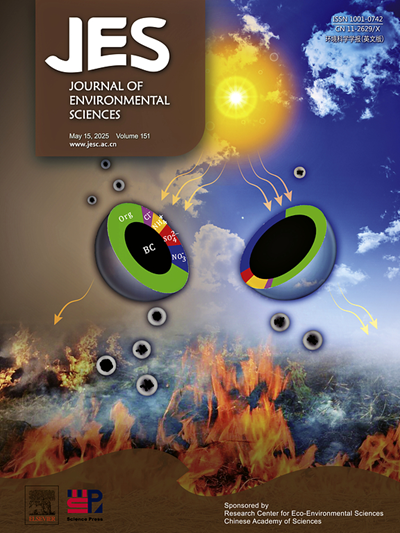Enhancement effect of biomass-derived carbon quantum dots (CQDs) on the performance of dye-sensitized solar cells (DSSCs)
IF 5.9
2区 环境科学与生态学
Q1 ENVIRONMENTAL SCIENCES
引用次数: 0
Abstract
Corn stover, an agricultural waste, was used to prepare nitrogen self-doped carbon quantum dots (CQDs) through a simple hydrothermal method with only water at near room temperature for the first time. The surface, electrochemical, and photovoltaic characteristics of CQDs doped TiO2 in dye-sensitized solar cells (DSSCs) were thoroughly and systematically examined. The average diameter of blue-fluorescence CQDs measured by a high-resolution transmission electron microscope (HR-TEM) was 4.63 ± 0.87 nm, which consisted of polar functional groups. The highest occupied molecular orbital (HOMO) and lowest unoccupied molecular orbital (LUMO) energy of the biomass-derived CQDs, determined by the cyclic voltammetry (CV) test, were, −5.48 eV and −3.89 eV, respectively. The negative shift of flat band potential (Vfb) in CQDs incorporated photoanode implies the fermi level shifted upward. Experimental results revealed that the improved performance of DSSCs was due to charge transport enhancement and separation, which resulted in the improved energy level configuration between TiO2, CQDs, and electrolytes. In this regard, the CQDs serve as a mediator that enables charge carrier transport without hindrance. In this study, CQDs added to TiO2 + N719, increased short circuit current density (JSC) and power conversion efficiency (PCE) value by ∼26.00 % (10.13 to 12.69 mA/cm2) and 27.20 % (4.78 % to 6.08 %), respectively.

生物质衍生碳量子点(CQDs)对染料敏化太阳能电池(DSSCs)性能的增强作用
首次利用农业废弃物玉米秸秆,在近室温条件下,采用简单的水热法制备了氮自掺杂碳量子点(CQDs)。对染料敏化太阳能电池(DSSCs)中掺杂TiO2的CQDs的表面、电化学和光伏特性进行了全面、系统的研究。高分辨率透射电镜(HR-TEM)测得的蓝色荧光CQDs平均直径为4.63±0.87 nm,由极性官能团组成。通过循环伏安法(CV)测试,生物质CQDs的最高已占据分子轨道(HOMO)和最低未占据分子轨道(LUMO)能量分别为- 5.48 eV和- 3.89 eV。在加入光阳极的cqd中,平带电位(Vfb)的负位移表明费米能级向上移动。实验结果表明,DSSCs性能的提高是由于电荷输运增强和分离,导致TiO2、CQDs和电解质之间的能级构型得到改善。在这方面,CQDs可以作为一种介质,使电荷载流子无阻碍地传输。在本研究中,将CQDs添加到TiO2 + N719中,短路电流密度(JSC)和功率转换效率(PCE)值分别提高了~ 26.00% (10.13 ~ 12.69 mA/cm2)和27.20%(4.78% ~ 6.08%)。
本文章由计算机程序翻译,如有差异,请以英文原文为准。
求助全文
约1分钟内获得全文
求助全文
来源期刊

Journal of Environmental Sciences-china
环境科学-环境科学
CiteScore
13.70
自引率
0.00%
发文量
6354
审稿时长
2.6 months
期刊介绍:
The Journal of Environmental Sciences is an international journal started in 1989. The journal is devoted to publish original, peer-reviewed research papers on main aspects of environmental sciences, such as environmental chemistry, environmental biology, ecology, geosciences and environmental physics. Appropriate subjects include basic and applied research on atmospheric, terrestrial and aquatic environments, pollution control and abatement technology, conservation of natural resources, environmental health and toxicology. Announcements of international environmental science meetings and other recent information are also included.
 求助内容:
求助内容: 应助结果提醒方式:
应助结果提醒方式:


